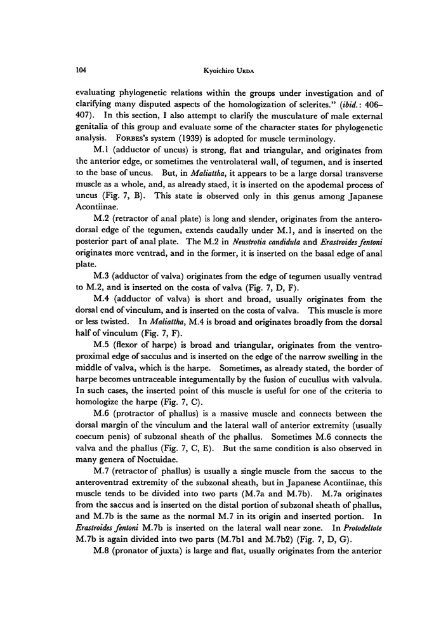A revision of the genus Deltote RL and its allied genera from Japan ...
A revision of the genus Deltote RL and its allied genera from Japan ...
A revision of the genus Deltote RL and its allied genera from Japan ...
Create successful ePaper yourself
Turn your PDF publications into a flip-book with our unique Google optimized e-Paper software.
104 Kyoichiro Ueda<br />
evaluating phylogenetic relations within <strong>the</strong> groups under investigation <strong>and</strong> <strong>of</strong><br />
clarifying many disputed aspects <strong>of</strong> <strong>the</strong> homologization <strong>of</strong> sclerites." (ibid.: 406-<br />
407). In this section, I also attempt to clarify <strong>the</strong> musculature <strong>of</strong> male external<br />
genitalia <strong>of</strong> this group <strong>and</strong> evaluate some <strong>of</strong> <strong>the</strong> character states for phylogenetic<br />
analysis. Forbes's system (1939) is adopted for muscle terminology.<br />
M.1 (adductor <strong>of</strong> uncus) is strong, flat <strong>and</strong> triangular, <strong>and</strong> originates <strong>from</strong><br />
<strong>the</strong> anterior edge, or sometimes <strong>the</strong> ventrolateralwall, <strong>of</strong> tegumen, <strong>and</strong> is inserted<br />
to <strong>the</strong> base <strong>of</strong> uncus. But, in Maliattha, it appears to be a large dorsal transverse<br />
muscle as a whole, <strong>and</strong>, as already staed, it is inserted on <strong>the</strong> apodemal process <strong>of</strong><br />
uncus (Fig. 7, B). This state is observed only in this <strong>genus</strong> among <strong>Japan</strong>ese<br />
Acontiinae.<br />
M.2 (retractor <strong>of</strong> anal plate) is long <strong>and</strong> slender, originates <strong>from</strong> <strong>the</strong> anterodorsal<br />
edge <strong>of</strong> <strong>the</strong> tegumen, extends caudally under M. 1, <strong>and</strong> is inserted on <strong>the</strong><br />
posterior part <strong>of</strong> anal plate. The M.2 in Neustrotia c<strong>and</strong>idula <strong>and</strong> Erastroidesfentoni<br />
originates more ventrad, <strong>and</strong> in <strong>the</strong> former, it is inserted on <strong>the</strong> basal edge <strong>of</strong> anal<br />
plate.<br />
M.3 (adductor <strong>of</strong> valva) originates <strong>from</strong> <strong>the</strong> edge <strong>of</strong> tegumen usually ventrad<br />
to M.2, <strong>and</strong> is inserted on <strong>the</strong> costa <strong>of</strong> valva (Fig. 7, D, F).<br />
M.4 (adductor <strong>of</strong> valva) is short <strong>and</strong> broad, usually originates <strong>from</strong> <strong>the</strong><br />
dorsal end <strong>of</strong>vinculum, <strong>and</strong> is inserted on <strong>the</strong> costa <strong>of</strong>valva. This muscle is more<br />
or less twisted. In Maliattha, M.4 is broad <strong>and</strong> originates broadly <strong>from</strong> <strong>the</strong> dorsal<br />
half <strong>of</strong> vinculum (Fig. 7, F).<br />
M.5 (flexor <strong>of</strong> harpe) is broad <strong>and</strong> triangular, originates <strong>from</strong> <strong>the</strong> ventroproximal<br />
edge <strong>of</strong> sacculus <strong>and</strong> is inserted on <strong>the</strong> edge <strong>of</strong> <strong>the</strong> narrow swellingin <strong>the</strong><br />
middle <strong>of</strong> valva, which is <strong>the</strong> harpe. Sometimes, as already stated, <strong>the</strong> border <strong>of</strong><br />
harpe becomes untraceable integumentally by <strong>the</strong> fusion <strong>of</strong> cucullus with valvula.<br />
In such cases, <strong>the</strong> inserted point <strong>of</strong> this muscle is useful for one <strong>of</strong> <strong>the</strong> criteria to<br />
homologize <strong>the</strong> harpe (Fig. 7, C).<br />
M.6 (protractor <strong>of</strong> phallus) is a massive muscle <strong>and</strong> connects between <strong>the</strong><br />
dorsal margin <strong>of</strong> <strong>the</strong> vinculum <strong>and</strong> <strong>the</strong> lateral wall <strong>of</strong> anterior extremity (usually<br />
coecum penis) <strong>of</strong> subzonal sheath <strong>of</strong> <strong>the</strong> phallus. Sometimes M.6 connects <strong>the</strong><br />
valva <strong>and</strong> <strong>the</strong> phallus (Fig. 7, C, E). But <strong>the</strong> same condition is also observed in<br />
many <strong>genera</strong> <strong>of</strong> Noctuidae.<br />
M.7 (retractor <strong>of</strong> phallus) is usually a single muscle <strong>from</strong> <strong>the</strong> saccus to <strong>the</strong><br />
anteroventrad extremity <strong>of</strong> <strong>the</strong> subzonal sheath, but in <strong>Japan</strong>ese Acontiinae, this<br />
muscle tends to be divided into two parts (M.7a <strong>and</strong> M.7b). M.7a originates<br />
<strong>from</strong> <strong>the</strong> saccus <strong>and</strong> is inserted on <strong>the</strong> distal portion <strong>of</strong> subzonal sheath <strong>of</strong> phallus,<br />
<strong>and</strong> M.7b is <strong>the</strong> same as <strong>the</strong> normal M.7 in <strong>its</strong> origin <strong>and</strong> inserted portion. In<br />
Erastroides fentoni M.7b is inserted on <strong>the</strong> lateral wall near zone. In Protodeltote<br />
M.7b is again divided into two parts (M.7bl <strong>and</strong> M.7b2) (Fig. 7, D, G).<br />
M.8 (pronator <strong>of</strong>juxta) is large <strong>and</strong> flat, usually originates <strong>from</strong> <strong>the</strong> anterior
















